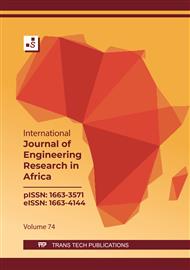[1]
J. Yin, R. Liu, R. Zhang, et al., A new tribo-dynamics model for engine connecting rod small- end bearing considering elastic deformation and thermal effects, Tribol. Int. 188 (2023) 108831.
DOI: 10.1016/j.triboint.2023.108831
Google Scholar
[2]
W. M. K. Helal, W. Zhang, X. Li, G. Wang, Y. Su, G. Chen, Analysis of a low-speed diesel engine connecting rod based on orthogonal simulation test, J. Phys.: Conf. Ser. 2093 (2021) 012023
DOI: 10.1088/1742-6596/2093/1/012023
Google Scholar
[3]
W. M. K. Helal, W. P. Zhang, X. B. Li, G. X. Wang, A study on the fatigue strength of a low-speed diesel engine connecting rod made of 42CrMoA, Int. J. Eng. Res. Afr. 49 (2020) 139–151
DOI: 10.4028/www.scientific.net/jera.49.139
Google Scholar
[4]
D. Croccolo, M. De Agostinis, S. Fini, G. Olmi, L. Paiardini, F. Robusto, Tribological properties of connecting rod high strength screws improved by surface peening treatments, Metals 10 (2020) 344
DOI: 10.3390/met10030344
Google Scholar
[5]
Q. Dou, H. Luo, Y. Song, Z. Zhang, J. Zhang, Failure analysis of diesel engine connecting rod Big-End bearing wear considering coupled clearance lubrication joints, Eng. Fail. Anal. 169 (2025) 109136
DOI: 10.1016/j.engfailanal.2024.109136
Google Scholar
[6]
M. N. Ilman, R. A. Barizy, Failure analysis and fatigue performance evaluation of a failed connecting rod of reciprocating air compressor, Eng. Fail. Anal. 56 (2015) 142-149
DOI: 10.1016/j.engfailanal.2015.03.010
Google Scholar
[7]
C. Juarez, F. Rumiche, A. Rozas, J. Cuisano, P. Lean, Failure analysis of a diesel generator connecting rod case study, Eng. Fail. Anal. 7 (2016) 24-31
DOI: 10.1016/j.csefa.2016.06.001
Google Scholar
[8]
W. M. K. Helal, W. Zhang, X. Li, G. Wang, Y. Su, Wear analysis of a low-speed diesel engine connecting rod based on orthogonal simulation test, J. Phys.: Conf. Ser. 2093 (2021) 012014
DOI: 10.1088/1742-6596/2093/1/012014
Google Scholar
[9]
A. Muhammad, M. A. H. Ali, I. H. Shanono, Design optimization of a diesel connecting rod, Materials Today: Proceedings 22 (2020) 1600–1609
DOI: 10.1016/j.matpr.2020.02.122
Google Scholar
[10]
S. Seralathan, S. V. Mitnala, R. S. K. Reddy, I. G. Venkat, D. R. T. Reddy, V. Hariram, T. M. Premkumar, Stress analysis of the connecting rod of compression ignition engine, Materials Today: Proceedings
DOI: 10.1016/j.matpr.2020.06.137
Google Scholar
[11]
S. Yadav, S. K. Gautam, R. Upadhyaya, N. K. Singh, K. K. Singh, A. Namdev, Die design optimization for connecting rod using simulation modeling and Taguchi methodology, Eng. Res. Express 6(3) (2024)
DOI: 10.1088/2631-8695/ad6d2b
Google Scholar
[12]
H. Jia, S. Li, Finite element structural simulation of connecting rod, J. Phys.: Conf. Ser. 2468(1) (2023) 012068
DOI: 10.1088/1742-6596/2468/1/012068
Google Scholar
[13]
F. Hu, Q. He, B. Fu, M. Zhao, M. Yang, Reliability analysis of diesel engine connecting rod threaded connection based on ANSYS, J. Phys.: Conf. Ser. 2459 (2023) 012095
DOI: 10.1088/1742-6596/2459/1/012095
Google Scholar
[14]
P. S. Gorane, R. S. Fegade, N. S. Sampat, V. B. Roundal, G. D. Siraskar, P. S. Patil, S. Gadhave, V. K. Javanjal, Finite element analysis (FEA) of Swift's connecting rod considering "I" cross section, Panamerican Mathematical Journal 33(2) (2023)
DOI: 10.52783/pmj.v33.i2.872
Google Scholar
[15]
S. Songklanakarin, S. Ali, Investigation of stresses at a critical location for shape optimization of connecting rod using finite element analysis, J. Sci. Technol. 45(2) (2023) 264-269.
Google Scholar
[16]
P. S. Gorane, V. B. Roundal, Connecting rod design along with analysis: A review, J. Autom. Automob. Eng. 7(1) (2022) e-ISSN: 2582-3159.
Google Scholar
[17]
J. Shu, X. Fu, A topology optimization design of compressor connecting rod, J. Phys.: Conf. Ser. 2383 (2022) 012022
DOI: 10.1088/1742-6596/2383/1/012022
Google Scholar
[18]
S. Saxena, R. K. Ambikesh, Design and finite element analysis of connecting rod of different materials, AIP Conf. Proc. 2341 (2021) 020034
DOI: 10.1063/5.0049989
Google Scholar
[19]
S. Saxena, R. K. Ambikesh, Design and finite element analysis of connecting rod of different materials, AIP Conf. Proc. 2341(1) (2021). Retrieved from
DOI: 10.1063/5.0049989
Google Scholar
[20]
G. Shanmugasundar, M. Dharanidharan, D. Vishwa, A. S. Kumar, Design, analysis and topology optimization of connecting rod, Materials Today: Proceedings 46 (2021) 3430-3438. Retrieved from
DOI: 10.1016/j.matpr.2020.11.778
Google Scholar
[21]
T. Sathish, S. D. Kumar, S. Karthick, Modelling and analysis of different connecting rod material through finite element route, Materials Today: Proceedings 21(1) (2020) 971-975. Retrieved from
DOI: 10.1016/j.matpr.2019.09.139
Google Scholar
[22]
A. Muhammad, et al., Finite element analysis of a connecting rod in ANSYS: An overview, IOP Conf. Ser.: Mater. Sci. Eng. 736 (2020) 022119.
DOI: 10.1088/1757-899x/736/2/022119
Google Scholar
[23]
P. Mishra, R. Singh, P. Pachorkar, R. Singh, A. K. Sharma, Y. S. Rajpoot, Design and static analysis of connecting rod of a petrol engine using FEA, in: Processing and Fabrication of Advanced Materials, vol. 1, pp.465-475, 2024
DOI: 10.1007/978-981-97-5959-0_31
Google Scholar
[24]
F. H. Fu, H. Zhang, L. Zhang, P. Niu, X. Liu, O. Stelmakh, The loosening mechanism of tin-bronze bushing assembled by interference at connecting rod small end of heavy-duty diesel engines, Int. J. Engine Res. 0(0) (2024)
DOI: 10.1177/14680874241272922
Google Scholar
[25]
W. Arso, M. N. C. Wan, A. F. M. Ayob, W. N. W. Mansor, Failure analysis of a connecting rod bearing of a diesel engine generator set, in: Exploring Diversity in Engineering and Technology for Knowledge and Innovation, pp.123-131, 2024
DOI: 10.1007/978-3-031-64330-9_10
Google Scholar
[26]
F. Renso, S. G. Barbieri, V. Mangeruga, M. Giacopini, Finite element analysis of the influence of the assembly parameters on the fretting phenomena at the bearing/big end interface in high-performance connecting rods, Lubricants 11(9) (2023) 375
DOI: 10.3390/lubricants11090375
Google Scholar
[27]
W. Wilarso, F. Azharul, A. Surya, A. Dharmanto, Failure bushing small end connecting rod diesel engine 3500 series, AIP Conf. Proc. 2702 (2023) 040015
DOI: 10.1063/5.0154252
Google Scholar
[28]
W. Wilarso, C. W. M. Noor, A. F. M. Ayob, W. N. W. Mansor, Investigation and failure analysis of a diesel generator connecting rod, Mech. Eng. Soc. Ind. 2(2) (2022) 64–71
DOI: 10.31603/mesi.6624
Google Scholar
[29]
Y. Wei, et al., Effect of different microstructures on the performance of air-cooled forging steel 46MnVS5 fracture splitting connecting rod, Materials Science Forum 941 (2018) 358-363. https://www.scientific.net/MSF.941.358
DOI: 10.4028/www.scientific.net/msf.941.358
Google Scholar
[30]
Information on https://www.ansys.com
Google Scholar


